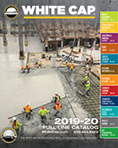How To Avoid OSHA Silica Dust Fines
OSHA is serious about reducing silica dust exposure to workers.
OSHA is handing out some hefty fines
OSHA is serious about reducing construction worker exposure to respirable dust. By the end of the first quarter of 2018, OSHA and state safety agencies have reported issued 116 violations to OSHA §1926.1153. Even though OSHA has only reported issuing 116 violations, we typically see a lag time between enforcement and the associated costs of fines, so we expect to see that number grow rapidly.
The majority of these violations (80%) were classified as serious. The highest fine imposed in this period was $9,239 per day, (short of the potential maximum fine of $12,934 per day). Most of the citations cited for dust exposure in this period occurred on jobsites that also had other citations such as failure to provide fall protection equipment and other unsafe situations. (Not an uncommon occurrence. Once OSHA is on your jobsite they often unearth additional violations).
The most frequently mentioned violation, in these citations, involved contractors allegedly failing to measure silica levels. The next most common violation was inspectors observing that worker protection from dust exposure did not comply with the regulation’s Table 1. (Table 1 identifies 18 common dust generating activities and recommended procedures contractors can follow to reduce exposure.)
OSHA Maximum Penalty Amounts (As of January 2018)
| Type of Violation | Penalty |
| • Serious • Other-Than-Serious • Posting Requirements |
$12,934 per violation |
| • Failure to Abate | $12,934 per day beyond the abatement date |
| • Willful or Repeated | $129,336 per violation |
Avoid Masking the Problem
Many contractors have the misconception that providing workers with respirators sufficient to reduce a worker’s exposure is enough. OSHA s1926.1153 requires contractors to reduce exposure to dust for the entire shift, not just during tasks that generate the most dust.
OSHA expects contractors to adopt operational and engineered solutions to reduce all dust exposure that may occur on the jobsite.
The exposure reducing guidelines for the 18 most common dust-generating construction tasks listed in Table 1 of the standard are the minimal expectations. Contractors should view respirators as one part of an effective dust containment program that should be adopted on the jobsite.
Contractors can better protect their workers from dust exposure by adopting new construction methods and investing in systems designed to reduce the amount of airborne dust. These methods improve workers long-term health, effect greater job site efficiency and increase operational margins.
Concrete Contractors Take a 3-Step Approach to Dust Control
1. Dust Suppression
On many projects, contractors can adopt dust suppression systems to control dust. Suppression techniques often include pre-wetting surfaces. For large areas, some contractors have installed misting sprayers that help contain fugitive dust.
OSHA allows contractors to use water to suppress airborne dust on common tasks such as jackhammering concrete. OSHA recommends this to be a team effort. One worker should direct a stream or spray of water at the impact point while another worker operates the jackhammer or powered chipping tool. The challenge with this engineered approach is that only wetting the surface is not sufficient to contain the dust. Workers must provide a continuous water application either streamed or sprayed at the point where the tool breaks through each new surface. And following the task’s completion, workers must take care to clean up the resulting slurry. Keep in mind that slurry collection requires specialized slurry vac, and appropriate disposal to meet EPA regulations.
Using engineered methods that don’t kick up any dust are a good way to reduce Silica on your jobsite. Rather than drilling and setting anchors after a slab is in place, consider using cast-in-place anchors. This method requires careful planning and checking for proper placement, but the upside is no drilling = no silica.
2. Dust Containment
OSHA references the use of Vacuum Dust Collection System (VDCS) on many of the tasks outlined in Table 1 of the standard to contain dust. A VDCS includes a hood or shroud that is placed at the point of contact between tool and concrete and a vacuum meeting the specifications recommended by the tool manufacturer, with enough suction to capture dust at the cutting point. The dust collector must have a filter with 99% or greater efficiency and a filter-cleaning mechanism.
Dust extractors are specialized VDCSs, customized designed to work with specific tools. Extractors commonly integrate the tool controls with the vacuum’s operation providing the precise amount of suction to eliminate airborne dust.
For many operations OSHA requires the use of respiratory protection with a minimum Assigned Protection Factor (APF) of 10 even when using VDCSs. For more information on requirements across multiple applications refer to OSHA’s Table 1.
When is a mask or respirator needed and which kinds should be used?
Using a respirator should be the last line of defense against silica dust, only after every possible engineered/environmental measure has been taken. The reality is not all engineered solutions are able to reduce exposure limits below the Permissible Exposure Limit (PEL) for silica. In those cases some type of PPE will be needed to ensure proper respiratory protection. When respirators are required, employers must implement a written respiratory protection program in accordance with OSHA’s Respiratory Protection standard 29 CFR 1910.134.
In silica environments an acceptable type of mask or respirator will have at least an APF-10 rating (Assigned Protection Factor). The APF is the level of protection a given respirator or mask is expected to provide assuming it is worn correctly and is in good working order. APF 10 means the device will provide protection in an environment containing 10 times the PEL for that particular hazard. OSHA and EPA consultant Chuck Paulausky has written a great article dealing with respirators and masks: Clearing the Air About Disposable Dust Masks
3. Increased Housekeeping
One key step to reducing dust exposure is adopt better housekeeping procedures. When cleaning up at the end of a project an effective way to remove silica dust is with a good vacuum equipped with a dust bag and HEPA filter. A quality HEPA vac system will keep worker exposure to a minimum during the bag removal and disposal process with an impermeable heavy-gauge plastic, or something similar.
If vacuuming is not possible carefully sweeping with a wax-based wet compound like Kleen Sweep Green or Brigade Green is an acceptable housekeeping method and can absorb dust and debris, including silica dust. When applied to a workplace floor, its wet silica particles remain on the floor until they are swept up and discarded.
Providing disposable washout and debris kits around the jobsite allows workers to easily contain dust generated by collected materials. The durable plastic bags are easily sealed and can be securely placed in the construction material dumpsters.
Another effective suppression approach is to install wall barriers. Installing drapes or containment barriers on open windows or doors can prevent the dust from drilling or chipping from entering the interior working area.
Effective use of barricades, like silica dust barricade tape, can keep workers out of areas where they could be exposed.
Contractors often use air scrubbers to contain dust in severe dust exposure areas. These portable filtration systems draw air in from the workplace and pass it through a series of filters to remove contaminants.
Another important housekeeping procedure is to place construction debris hoppers and wash out pits away from work areas. Monitor the frequency of the refuse removal as full dump hopper increases the amount of airborne dust on the jobsite.
For more helpful info on silica dust, useful tools and systems for various applications, and guarding against exposure, check out White Cap’s Silica Rule Info Page
Respiratory Protection in Construction: An Overview of Hazards & OSHA’s Program Requirements
Proteccion Respiratoria en la Construccion: Un Resumen de los Peligros Asociados Y los Requisitos Del Programa de la OSHA
The information provided herein is intended as a basic summary of certain rules, regulations and standards. It is not intended to be an official, legal, safety-related or comprehensive interpretation of any such rules, regulations or standards or an exhaustive list of the rules and regulations that may have been changed and/or otherwise apply to your business operations. You should always rely on your own review, evaluation and interpretation of rules, regulations and standards affecting your business. It is an individual and/or an employer’s obligation to comply with all applicable rules, regulations and standards. The information provided herein should not be interpreted as an endorsement or guarantee of performance of any products identified in the materials.
![]()
For more helpful info on silica dust control, Table 1 compliance, and additional resources, check out White Cap’s Silica Rule Info Page
The “Small Entity Compliance Guide” provides a great overview of OSHA’s Respirable Crystalline Silica Standard for Construction: https://www.osha.gov/Publications/OSHA3911.pdf







